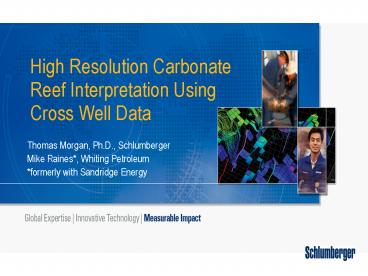High Resolution Carbonate Reef Interpretation Using Cross Well Data - PowerPoint PPT Presentation
1 / 32
Title: High Resolution Carbonate Reef Interpretation Using Cross Well Data
1
High Resolution Carbonate Reef Interpretation
Using Cross Well Data
- Thomas Morgan, Ph.D., Schlumberger
- Mike Raines, Whiting Petroleum
- formerly with Sandridge Energy
2
- Sites
- Michigan
- West Texas
- Focus
- Gross Structure
- Internal Structure
- Depositional Environments
3
- Geological Information
- Well Logs
- Geophysical Data
- Geological Interpretation
4
Michigan Silurian Reef
- Single profile
- Isolated pinnacle reef
- Only one additional well
- No surface seismic available
5
(No Transcript)
6
(No Transcript)
7
Tomographic Velocity Inversion
- Picked Direct Arrivals
- 3D Thin Layer Model
- 3D Ray Tracing
- Model Interfaces and Layer Parameters Described
by Chebyshev Polynomials
8
(No Transcript)
9
Imaging
- Kirchhoff Integral
- Prestack Reflection Imaging
- Depth
- Dip Oriented and Aperture Limited
- Ray Trace Travel Times from Tomographic
Velocities - Angle Gather Output
10
(No Transcript)
11
45 degrees
30 degrees
70 degrees
12
Interpretation Approach
- Profile is in Depth
- Exact depth tie at the wells
- no time to depth
conversion needed - Resolution at the outcrop level human scale
geology - Geological Interpretation versus Geophysical
Interpretation
13
(No Transcript)
14
Evaporites
Reef Zone
Grey Niagaran
Burnt Bluff Carbonate
15
(No Transcript)
16
Bioherm
17
Organic Reef
Bioherm
18
Organic Reef
Bioherm
19
Organic Reef
Bioherm
Reef Rubble
20
Supratidal Island
Organic Reef
Bioherm
21
Tidal Flats
Supratidal Island
Organic Reef
Bioherm
22
(No Transcript)
23
West Texas Permian Reef
- Multiple profiles
- More complicated structure
- Better well control
- Surface seismic available
24
Right
Middle
Left
25
(No Transcript)
26
Reef Top
Marker Near OWC
27
Stacked Mounds
Shaley Lag Deposit
Reef Top (Erosional)
On Lap
Inter-Mound CO3 Debris
Marker Near OWC
28
Stacked Mounds
Reef Top
Inter-Mound CO3 Debris
29
Shaley Lag Deposit
Reef Top
30
Conclusions
- Depth profiles provide unambiguous well ties
- Resolution allows a truer look at the geology
- Geophysical effects pushed down to smaller scale
- Reservoir level geologic Interpretation is
possible
31
High Resolution Interpretation of a Permian
Reef Michael A. Raines, Sandridge Tertiary,
LLC, Thomas R. Morgan, Ph.D., Schlumberger
Poster PDC P2, Station D1 Tuesday, October 27 at
1140 a.m.
32
Acknowledgments We would like to thank
Sandridge Energy and Michigan Technological
University for the use of the data.
References Bube, K., and R. Langan, 1999, On
a continuation approach to regularization for
crosswell tomography 69th Annual International
Meeting, SEG, Expanded Abstracts,
1295-1298. Liao, Q., and G. A. McMechan, 1997,
Tomographic imaging of velocity and Q, with
application to crosswell seismic data from the
Gypsy Pilot Site, Oklahoma Geophysics, 62,
1804-1811. Quan, Y., and J.M. Harris, 1997,
Seismic attenuation tomography using the
frequency shift method Geophysics, 62,
895-905. Huh, M.H., L.I. Briggs, and D. Gill,
1977, Depositional Environments of Pinnacle
Reefs, Niagaran and Salina Groups, Northern
Shelf, Michigan Basin, in Studies in Geology No.
5, Reefs and Evaporites Concepts and
Depositional Models, AAPG, J.H. Fisher ed.






























